Green Chemistry Education in the News:
Select a Category
Empowering Tomorrow’s Innovators: Celebrating the Impactful Initiatives of the 2022-2023 Green Chemistry Education Challenge Award Winners
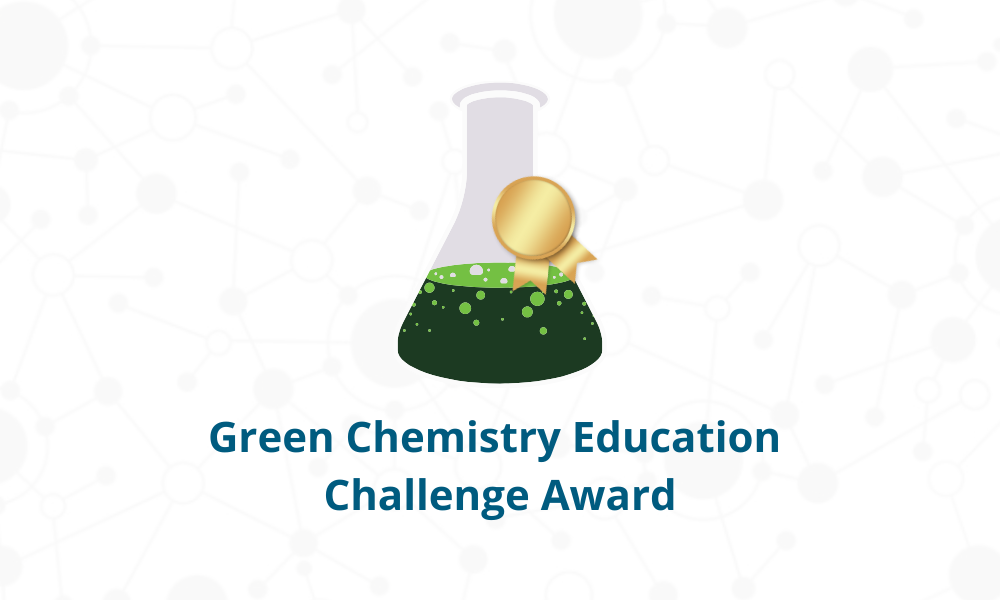 Congratulations to the remarkable 2022-2023 Green Chemistry Education Challenge Award winners for their outstanding contributions in designing innovative projects that are poised to advance green chemistry education within their institutions. By pioneering these initiatives, they are not only shaping the future of education but also leading the way toward a more sustainable world. We look forward to witnessing the positive impact their projects will have on both their campuses and the broader community.
Congratulations to the remarkable 2022-2023 Green Chemistry Education Challenge Award winners for their outstanding contributions in designing innovative projects that are poised to advance green chemistry education within their institutions. By pioneering these initiatives, they are not only shaping the future of education but also leading the way toward a more sustainable world. We look forward to witnessing the positive impact their projects will have on both their campuses and the broader community.
Thank you to our sponsors, Dow, Biogen and 3M, for their invaluable support in making these awards possible. Their commitment to fostering innovation in green chemistry education is instrumental to ensuring the workforce is trained with the green chemistry knowledge and skills needed for a sustainable future.
Beyond Benign’s Green Chemistry Education Challenge Awards aim to support the integration of green chemistry education into courses and curricula with financial aid to achieve impactful change. Strong applications receive funding to achieve the following goals:
- Increase the awareness of green chemistry and the Green Chemistry Commitment (GCC) program across the chemistry department and institution.
- Increase awareness of the institution’s dedication to green chemistry education through conference attendance, webinars, publications, social media campaigns, etc.
- Transform curriculum and lab procedures to achieve the GCC’s Green Chemistry Student Learning Objectives so all chemistry majors, upon graduation, have proficiency in the following essential green chemistry competencies: Theory, Toxicology, Laboratory Skills & Application.
If you would like to apply for a Green Chemistry Education Challenge Awards, we currently have two open applications. Application deadlines are October 31st.
If your organization would like to sponsor an award for faculty or students, please reach out to nicki_wiggins@beyondbenign.org
Dow Green Chemistry Education Challenge Awards
These five awards were provided to Green Chemistry Commitment Signing Institutions to accomplish 1-year green chemistry projects that advance the teaching and learning of green chemistry. The funding could be utilized to drive awareness for Green Chemistry or support the adoption of Green Chemistry curriculum into chemistry courses, laboratories and/or outreach activities. Funding support provided by Dow.
Winners:
Institution: Bradley University
Faculty Lead: Dean Campbell
Project Description: The primary objective of this project is to bring green chemistry concepts to the Bradley University students by incorporating a robust set of green chemistry labs into the General and Organic Chemistry laboratory courses. To accomplish this objective, the grant funding will be used to purchase supplies and reagents for use in these labs. With approximately a quarter of the 5,400 Bradley University students enrolled in General and Organic Chemistry labs, this provides an excellent opportunity to help increase awareness of green chemistry across the entire campus.
Institution: South Dakota State University (SDSU)
Faculty Lead: Sara K. Madsen
Project Description: Virtual Reality (VR) will be used to assess its learning effectiveness in Organic Chemistry laboratory that currently uses green chemistry pedagogy. The goal of this project is to use VR to provide chemistry students an opportunity to practice green chemistry techniques and experiments before entering a real space laboratory. SDSU faculty, staff, and administrators, SDSU students, and South Dakota Tribal Colleges will benefit from this project. This project will design a VR template that can achieve the following objectives:
- Practice the procedures of a traditional green experiment and non-green experiment and assess learning in VR.
- Conduct a green experiment and non-green experiment in the real laboratory space and assess learning, calculate energy consumption, atom economy and E-Factor, in both VR and non-VR spaces.
- Modify VR objects to optimize and pilot the green chemistry experiment in VR.
Institution: University of Minnesota
Faculty Lead: Nathan Rackstraw
Project Description: The Sustainable and Green Chemistry Committee (SGC) at the University of Minnesota (UMN) plans to:
1) increase the Chemistry department’s dedication to green chemistry by inviting an external guest speaker in the Fall semester of 2023.
2) increase awareness of current green chemistry practices (theory, toxicology, laboratory skills, and application of green chemistry) across the department by organizing monthly researcher (graduate student and postdoctoral scholar) roundtable meetings, and
3) transform an existing middle school science outreach program to incorporate green chemistry experiments into their curriculum.
Institution: University of Colorado, Colorado Springs
Faculty Lead: Nicole Juhl and Tisha Mendiola Jessop
Project Description: Faculty members, Nicole Juhl and Tisha Mendiola Jessop, design Green and Sustainable Chemistry modules to serve as models for their department as resources and concrete examples for how to incorporate green chemistry without adding to the curriculum. Additionally, they will increase and improve their education through professional development by attending the American Chemical Society Green Chemistry Institute (ACS GCI) Green Chemistry and Engineering Conference in June of 2023 and share their learnings with their colleagues over the 2023-2024 academic year.
Institution: Saint Francis University
Faculty Lead: Ashley Smith-Diemler
Project Description: This project seeks to expand Saint Francis University’s (SFU’s) awareness of the Green Chemistry Commitment in both our Chemistry Department and the larger surrounding community through the following objectives:
- Expand the application and teaching of Green Chemistry Principles for both the lecture and laboratory courses.
- Redesign Chemistry major seminar (taken one semester/year by all Chemistry majors) to focus on green chemistry principles, challenges, and core competencies.
- Create new green chemistry-themed activities that can be taught in local schools and libraries by the existing outreach organization (R.O.C.K. – Rural Outreach Chemistry for Kids).
Biogen Green Chemistry Education Challenge Awards
These two awards were given to Green Chemistry Commitment Signing Institutions who are US-based Minority Serving Institutions (MSIs) to accomplish 1-year green chemistry projects that advance the teaching and learning of green chemistry. The funding could be used to drive awareness for Green Chemistry or support the adoption of Green Chemistry curriculum into chemistry courses, laboratories and/or outreach activities. Funding support from Biogen.
Winners:
Institution: Kean University
Faculty Leads: Heather Stokes-Huby, Subhasish Chatterjee
Project Description: Kean University is starting a Green Chemistry Initiative and using a lab-based green chemistry dye activity to kick off the Initiative and to enhance and strengthen the interest of student participants. Through their Green Chemistry Initiative, Kean University will develop new laboratory experiments and courses in green chemistry and propose a green chemistry concentration within their chemistry major offerings at the University.
Institution: St. Edward’s University
Faculty Lead: Lauren Mitchell
Project Description: St. Edward’s University will implement a new green chemistry experiment into their introductory level Organic Chemistry lab course. Students will synthesize and purify aspirin at microscale quantities using specialized glassware, then they will compare their results to experiments run earlier in the semester to evaluate the greenness of different synthetic approaches and their impacts on waste reduction. St. Edward’s University will adapt future experiments in other Organic Chemistry lab courses to use the same microscale synthetic approach.
Green Chemistry Education Student Group Challenge Awards
These fourteen (14) Green Chemistry Education Awards were provided to student groups from Minority Serving Institutions (MSIs) to run three green chemistry events or outreach activities that advance the adoption of green chemistry on their campuses or in their local communities. This funding is to help support ACS Student Chapters enhance their applications for green chemistry recognition from the American Chemical Society Green Chemistry Institute. Funding provided by 3M and Beyond Benign.
3M Green Chemistry Education Student Group Challenge Awards – US Institutions:
Institution: California State University, San Marcos
Faculty Advisor: Robert Iafe
Project Plan: The CSUSM ACS Student Chapter will organize a Green Chemistry Summit event to introduce green chemistry to the campus and local community colleges, featuring Dr. John Warner as a keynote speaker. The group will also provide a tour of Genomatica (a green chemistry award winning biotech company based in San Diego) to showcase a local industry example of green chemistry research applications. The group’s final project includes running a green chemistry outreach activity to a local high school, where a green chemistry experiment to create a solar cell will be used to discuss alternative energy, emissions prevention, and redox chemistry.
Institution: University of Minnesota, Twin Cities
Faculty Advisor: Jane Wissinger
Project Plan: The ACS-UMN Student Chapter will run a short seminar series for the Department of Chemistry to highlight green chemistry in different industries. Guest speakers from diverse backgrounds such as pharmaceutics, chemical engineering, and medicinal chemistry will be invited. Members of the Student Chapter will volunteer at local elementary and middle schools to run green chemistry demonstrations as outreach activities. Finally, the Student Chapter will run general educational meetings for undergraduate students at the University of Minnesota. These meetings will discuss ocean acidification and the use of sustainable starting materials in chemistry research and will use lesson plans and activities from Beyond Benign.
Institution: Texas Woman’s University (TWU)
Faculty Advisor: John Beatty
Project Plan: The TWU-KEM Club will run two Chemistry Magic Show events, for homeschooled students, and for local high school students. In these events, students will learn about microplastics in the environment and the importance of finding greener alternatives to plastics through participation in a bioplastics green chemistry experiment. The local high school students will be invited to the TWU campus along with their dual credit teachers. Finally, the TWU-KEM Club will expand their Zero Impact Events on Campus Program through decreasing the use of single-use plastics and holding discussions on the importance of waste reduction.
Institution: Augsburg University
Faculty Advisor(s): Sarah Lam, Michael Wentzel
Project Plan: The Augsburg University ACS Student Chapter will run three outreach events for undergraduate students. The first outreach activity will be an Advanced Biomimicry Matching Game, where students will understand the concept of biomimicry and learn about the impact of carbon dioxide on the environment through exploring acid and base chemistry in the context of less hazardous synthesis, designing for degradation, and using benign solvents. The second outreach activity will discuss endangered and critical elements, and how challenges associated with their sustainable use and preservation will impact the future of chemistry for energy storage research (batteries, supercapacitors, etc.). Finally, the Student Chapter will run a task-based scavenger hunt to connect the principles of green chemistry to students’ real-world environments, and to further their understanding of how green chemistry can be used to solve local sustainability challenges.
Institution: Hampton University
Faculty Advisor(s): Dawanna White, Oluwatoyin Asojo
Project Plan: The Hampton University ACS Student Chapter will run three events. The first event is titled “A Greener Future of Chemistry” and will introduce the audience to the concept of green chemistry. Speakers will be invited that will discuss the intersection of green chemistry and environmental justice. Their second event will be a community-based event run locally, where simple green chemistry experiments will be conducted by school-aged children to find ways to reduce waste and be eco-friendly in the chemistry laboratory. Finally, the Student Chapter’s third project is a department-wide “HU Chem Goes Green” competition to push chemistry and biochemistry undergraduate majors to practice green chemistry. Students will compete to see who can design and conduct the most hazard-free chemical reaction.
Institution: University of Puerto Rico, Mayagüez
Faculty Advisor: Carmen Amaralis Vega
Project Plan: The ACS-RUM Student Chapter at the University of Puerto Rico, Mayagüez will design and conduct three green chemistry workshops in the chemistry laboratories. These workshops will be attended by undergraduate students interested in green chemistry and will focus on how to synthesize chemicals using green reaction pathways. Promotion to other student members and professionals will be conducted through social media.
Institution: Prairie View A&M University (PVAMU)
Faculty Advisor: Andrea Oseolorun
Project Plan: The Chemistry Student Group at PVAMU will design and run three projects for the chemistry department. The first project is the creation and initiation of a departmental pilot composting program for spent coffee grounds and tea leaf waste to be used in a community garden project. Students will focus on green chemistry concepts centering on the reduction of waste and circular economics. The second project comprises a campus-wide green and sustainable chemistry poster campaign to introduce the entire campus to green and sustainable chemistry and to encourage widespread incorporation of Green Chemistry Principles and Practices. Finally, the third project involves designing and shooting a sustainability video to promote Green Chemistry Principles and sustainability concepts.
Institution: University of Puerto Rico, Rio Piedras
Faculty Advisor: Ingrid Montes
Project Plan: The University of Puerto Rico, Rio Piedras Student Chapter will run three events. The first event is a green chemistry section as part of a larger “Show of The Magic of Chemistry”, an annual signature student group event designed to outreach to local community members of all ages. The green chemistry section will include experiments to educate the public on pollution prevention, ocean acidification, and sustainable fabric dyes and textiles. The second event is a series of green chemistry hands-on demonstrations for K-12 students where participants will perform experiments using household products. Students will learn about green polymers and designing for degradation, in addition to understanding the importance of using safer alternatives when designing products. Finally, a green chemistry scavenger hunt event will be run for undergraduate students in the chemistry department, where Green Chemistry Principles are used as clues to determine scavenger hunt locations and to educate the general university community about the importance of incorporating green chemistry into daily life.
Institution: Wayne State University
Faculty Advisor: Susan White
Project Plan: The WSU ACS Student Chapter hosted a featured speaker as part of a Green Chemistry Seminar in the Department of Chemistry. Wayne State University’s Associate Director of Hazardous Materials gave a talk on waste removal processes on campus, and how green chemistry impacted her job. Audience members interacted with the speaker during Q&A sessions and additionally learned about the importance of waste reduction and circular economics. The second event run by the Student Chapter included a baking experiment to simulate the Green Chemistry Principle of catalysis for more efficient reactions. Undergraduate students learnt how catalysts work using two methods to bake cupcakes. The third event was a green chemistry experiment for undergraduate students to make biodegradable plastic from milk and lemon juice. Students learned about the harmful processes associated with commercial plastic production and how implementing Green Chemistry Principles can create similar working products that are safer for the environment.
Institution: Tuskegee University
Faculty Advisor: Melissa Reeves
Project Plan: The Tuskegee SCACS Student Group will conduct three outreach activities. The first event will teach children at nearby schools about the importance of clean drinking water and water filtration by walking students through hands-on activities such as Beyond Benign’s desalination lesson. The second outreach activity will bring awareness to community members about the levels of plastic in the ocean and effects of water pollution through a recycling-centered full day event. Participants will learn about the chemistry of water pollution and how practicing green chemistry can mitigate water pollution. The final outreach activity will be a “green thumb” event where participants will plant various flowers while learning about the chemistry of air pollution and how toxins can be absorbed into plants. Audience participants will comprise middle school age children and Tuskegee undergraduate students.
Beyond Benign Green Chemistry Education Student Group Challenge Awards – International Institutions:
Institution: University of Ilorin
Faculty Advisor: Joshua Obaleye
Project Plan: The ACS Student Chapter at the University of Ilorin in Nigeria is planning three events to introduce and advocate for green chemistry on their campus. A seminar series will be hosted for the student body featuring green chemistry experts, where the principles and applications of green chemistry will be introduced to attendees. A waste-centered event will also be hosted, where participants will learn how to derive useful bio-active ingredients from local waste products. Lastly, the Student Chapter plans to run a green chemistry quiz and debate competition that is designed to foster further understanding of green chemistry for current and future generations of students.
Institution: The University of the West Indies, Mona
Faculty Advisor: Andrea Goldson-Barnaby
Project Plan: The ACS Jamaica International Student Chapter at the University of the West Indies, Mona, hosted several outreach activities funded through this award. In January and in June, the Student Chapter hosted students from the Buff Bay High School in Portland, where they were introduced to basic green chemistry concepts through interactive presentations and hands-on experiments to make a pH indicator from red cabbage and plastics from starch and milk. In February the Student Chapter hosted students from PGA Preparatory School for a day of interactive chemistry experiments using green practices and methods. Students tested the surface tension of water, investigated polymer interlacing, and understood gas production from chemical reactions using green materials. A science fair booth was hosted by the Student Chapter where green chemistry experiments were showcased for students across the country who attended. Additionally, in May, students from the Lister Mair Gilby School for the Deaf were funded to go on a field trip to Port Royal to learn about the importance of environmental protections through observing different ecosystems.
Institution: Yachay Tech University
Faculty Advisor: Thibault Terencio
Project Plan: The ACS Student Chapter Club de Química at Yachay Tech University will run events designed to support student understanding of green chemistry on campus and in local communities. Students will have an opportunity to visit a local industrial plant that focuses on applying green chemistry principles into their procedures to show students practical applications of green chemistry knowledge. Additionally, the student chapter will run a three-day crash course on biopolymers, featuring a workshop and talks to teach students how to use Ecuadorian agricultural residues to synthesize biopolymers as a tool for bioremediation. Conference presentations on circular economy principles will be highlighted through this award, allowing student work to be uplifted at different Ecuadorian universities. Finally, the Student Chapter will run a science fair outreach activity with local high school students to further their understanding and application of green chemistry.
Institution: UFRJ
Faculty Advisor: Estevão Freire
Project Plan: The ACS Student Chapter at the Universidade Federal do Rio de Janeiro will host several events to further understanding and promotion of green chemistry to students across the educational spectrum. These events include running green chemistry experiments on-campus and at local schools during the National Week of Science and Technology. Experiments will include a variety of themes, including fostering inclusive learning environments for students who are deaf and blind. The Student Chapter is running the Brazilian Green Chemistry Olympics, where they will additionally be awarding prizes to students at the school and university levels who have demonstrated high knowledge of green chemistry and its applications in society. The Student Chapter will also support the second-ever hybrid Green Chemistry Winter School hosted at UFRJ, where a Student Paper Contest will be hosted to motivate students to share their green chemistry research projects. The Student Chapter will also participate in hosting the second Latin American Congress of Green Chemistry, which includes representatives from Brazil, Costa Rica, Colombia, Mexico, and Guatemala. A panel discussion, lectures, a round table, and invited speakers will be supported. Finally, the Student Chapter will host the second Interchapter Meeting Brazil to promote sustainability and green chemistry actions to institutions across Brazil. ACS Student Chapters from different regions in Brazil will participate in this forum to share initiatives and actions that have been carried out to advance green chemistry at their home institutions, and to plan for future green chemistry actions needed in Brazil.

Empowering Tomorrow’s Innovators: Celebrating the Impactful Initiatives of the 2022-2023 Green Chemistry Education Challenge Award Winners
October 17, 2023
Congratulations to the remarkable 2022-2023 Green Chemistry Education Challenge Award winners for their outstanding contributions in designing innovative projects that are poised to advance green chemistry education within their institutions. […]
Categories: Green Chemistry Education, Higher-Ed
Empowering Classroom Safety: Stefanie Loomis’s Green Chemistry Journey
In the face of a classroom emergency, Stefanie Loomis’s proactive adoption of green chemistry practices not only ensured the safety of her students and colleagues but also showcased the transformative power of these principles in education.
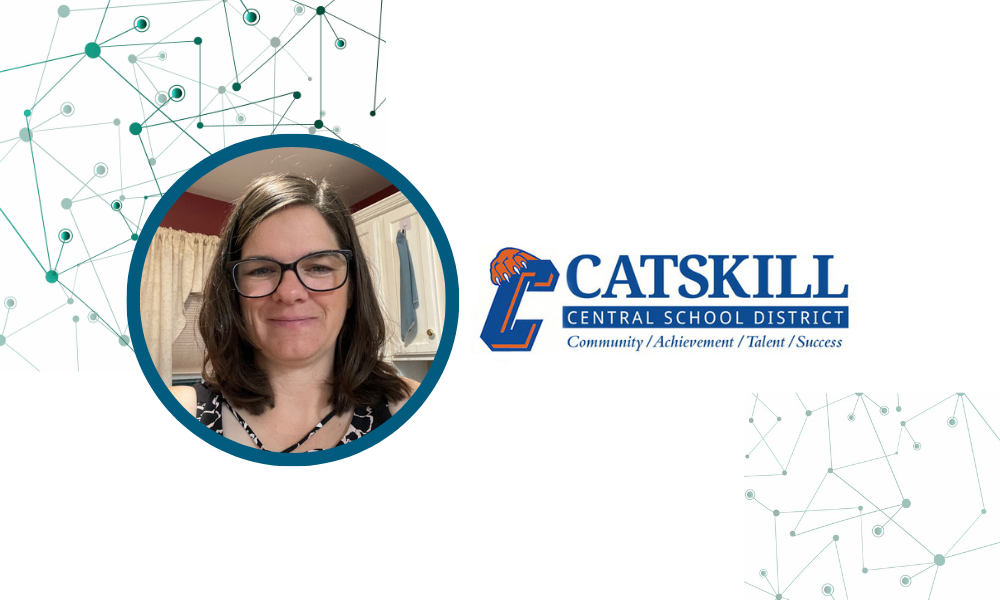 Catskill Senior High School in New York State recently received the kind of news that no school wants to hear during construction. A broken pipe was discovered in the crawl space under the science classrooms with a puddle of unidentified liquid underneath. Stefanie Loomis, a high school chemistry and physics teacher and Beyond Benign Lead Teacher, was teaching above that crawl space.
Catskill Senior High School in New York State recently received the kind of news that no school wants to hear during construction. A broken pipe was discovered in the crawl space under the science classrooms with a puddle of unidentified liquid underneath. Stefanie Loomis, a high school chemistry and physics teacher and Beyond Benign Lead Teacher, was teaching above that crawl space.
Several years prior, Stefanie met Annette Sebuyira, a Beyond Benign Certified Lead Teacher, at Siena College’s Green Chemistry Institute. The meeting sparked a collaboration that would shape Stefanie’s educational approach.
After meeting Annette, Stefanie enrolled in Beyond Benign’s intro and advanced courses and subsequently joined the Lead Teacher Program. Through this immersive experience, and with the help of supportive peers including a higher-education colleague at Siena College, she delved into the intricacies of lab safety, a domain she had previously navigated instinctively.
“I was a research chemist right out of college,” says Stefanie. “When I first started teaching, I knew nothing about education, so I just followed what all the other teachers were doing. That’s what they told me to do. Then I started to learn that that wasn’t a good idea.”
Stefanie’s encounter with green chemistry principles illuminated a safer and more innovative path, prompting a significant shift in her educational paradigm. That shift was a game-changer when Catskill Senior High School discovered the broken pipe.
A Lab-Safety Transformation
In 2014, Stefanie Loomis had embarked on a transformative journey toward greener, safer, and more sustainable teaching practices.
“When I first started teaching at Catskill, the chem closet was full of stuff that was older than me,” says Stefanie. “The labels were falling off.” Some of the chemicals in her inherited chem closet were dangerous, and had chemicals in them with labels warning against use for those of child-bearing age.
Guided by the principles of green chemistry, she began eliminating these hazardous chemicals, and meticulously examining her lab protocols. Collaborating with colleagues, she orchestrated the disposal of substances that posed risks, ensuring a safer environment for both students and staff.
“My chem closet is beautiful now,” says Stefanie. “The health and safety people will tell you that my chem closet is one of the cleanest and most well-organized they’ve seen, because we have gotten rid of anything and everything that we don’t use. And what we do use, we make sure we only have small amounts of.”
Perhaps the most significant impact of Stefanie’s efforts was the profound sense of security she instilled within her colleagues.
“One of our teachers was very excited when I told her what I’ve done,” says Stefanie, “and she’s more enthusiastic because she feels so much safer being in the lab. So not only do the kids feel safer, she feels safer, which is huge.”
As Stefanie’s reputation as a trailblazer in green chemistry spread, her influence expanded, encouraging others to embrace similar changes.
The Broken Pipe
In the spring of this year, the broken pipe underneath Stefanie’s chemistry classroom triggered a response that showcased the depth of her dedication to safety and preparedness. The broken pipe resulted in immediate alarm, and Stefanie was asked by the local safety department to compile a comprehensive inventory of all her lab materials and chemicals. This directive came with a sense of urgency.
“They told me that I needed to list every lab performed and every chemical that I had used in the last three years,” says Stefanie, “including how much of each reactant and product could have possibly gone down the drain. They didn’t know how long the pipe had been broken, and there was standing water under it. They needed to find out if chemicals were in that water and what they might be.”
Stefanie meticulously sifted through her lab plans, consulting her science binders and safety data sheets. Collaborating with a fellow teacher, she diligently cataloged every chemical used in her classroom.
“Fortunately, at this point my chemistry labs are pretty green,” says Stefanie. “I have transitioned most of my labs over to household chemicals, or they’re at micro scale, or the products are safe to go down the drain. Most of the labs the students can even do at home.”
Stefanie’s proactive approach to safety was evident during this crisis. When the test results arrived, affirming the safety of her classroom, relief permeated the school. Stefanie’s conscientious efforts had not only averted a potential disaster but also highlighted her classroom’s exceptional safety standards, with air quality ratings confirming the absence of harmful substances.
“I’ve been thanked by the Health and Safety Department,and I’ve been thanked by my principal, just saying, ‘We are so happy you were doing what you were doing, because this could have been a lot worse!’” she says.
The Future of Green Chemistry Education
Stefanie’s experience proves that embracing green chemistry in the classroom doesn’t always require a drastic overhaul; instead, it can be a gradual, seamless process. Her approach offers valuable insights for fellow teachers seeking to incorporate eco-friendly practices into their curriculum.
Stefanie emphasizes that the integration of green chemistry doesn’t demand explicit declarations; it can seamlessly operate in the background of classroom activities. By choosing safer chemicals and innovative teaching methods, teachers can subtly convey the essence of green chemistry.
“As time went on, I continued to pick two or three labs a year and find ways to substitute safer chemicals,” says Stefanie. “Transitioning to green chemistry wasn’t a lot more work, because I did it gradually.”
Stefanie’s journey underscores the significance of thoughtful planning and resource utilization.
“When I first learned about green chemistry, I thought it was something you did one time, and then you were done,” says Stefanie. “It’s not. It’s a continual thing. You’re constantly changing and editing and learning and applying.”
Evaluating each lab, considering alternatives, and discussing these choices with peers can guide educators toward more sustainable options. Collaboration and knowledge-sharing, evident in Stefanie’s engagement with the Siena College Green Chemistry Institute and her peers, can be instrumental in making informed decisions about chemical choices.
Green Chemistry in Action: How Not to Make Lemonade
Inspired by a Beyond Benign course, Stefanie has turned a simple lemonade-making activity into an engaging lesson on green chemistry principles. Through a humorous skit highlighting flawed lab practices, her students learn to critically analyze procedures and identify areas for improvement.
“I over-emphasize a really bad lab procedure,” says Stefanie, “and then I have them rewrite the procedure in their own words, sharing how we can make this a better procedure. Then they make their own lemonade at the end. This is how I introduce the green chemistry principles.”
This hands-on approach not only instills essential knowledge but also nurtures creativity and innovative thinking.
Collaborating with fellow educator Annette Sebuyira, Stefanie has also created a captivating Halloween murder mystery storyline. In this scenario, students apply green chemistry concepts to solve a mystery, incorporating elements from various labs. The Density Lab challenges students to analyze plastics, determining their densities to identify the murder weapon. To decipher the composition of a mysterious red liquid, students devise their own procedures using the Lemonade Lab concept.
Presenting their findings at the Eastern STANYS conference, Stefanie and Annette showcased the seamless integration of Beyond Benign labs with real-world scenarios. Their approach not only demonstrated the practical application of green chemistry but also emphasized the importance of creativity, critical thinking, and problem-solving skills.
Stefanie Loomis continues to inspire both students and educators, illustrating the exciting potential of green chemistry in transforming K-12 science education. Connect with Stefanie on the Green Chemistry Teaching & Learning Community (GCTLC) platform and check out the resources (under learning objects) that she has shared.

Empowering Classroom Safety: Stefanie Loomis’s Green Chemistry Journey
October 16, 2023
In the face of a classroom emergency, Stefanie Loomis’s proactive adoption of green chemistry practices not only ensured the safety of her students and colleagues but also showcased the transformative […]
Categories: Green Chemistry Education, K-12, Newsletters
Preparing the Incoming Workforce for a Sustainable Future Through Green Chemistry
A Partnership Between Dow and Beyond Benign

Dow and Beyond Benign joined forces to prepare the next generation workforce for sustainable action through green chemistry education. This partnership is a powerful step toward creating systemic change in chemistry education and the designing sustainable materials in the marketplace using Dow’s ‘Safe Materials for a Sustainable Planet’ goal. By promoting systemic change at the molecular level, Beyond Benign envisions a workforce prepared to design processes and products that are healthy and safe for humans and the environment. Dow’s support will propel Beyond Benign’s goal to ensure 25% of graduating U.S. chemists have a background in green chemistry by 2025, equipped to design a sustainable future.
Beyond Benign is a non-profit organization co-founded in 2007 by Dr. Amy Cannon and Dr. John Warner dedicated to fostering and empowering a green chemistry community toward transforming chemical education. In 2013, Beyond Benign created the Green Chemistry Commitment program to support higher education institutions across the globe throughout the transition to a more sustainable curriculum. To date, approximately 125 universities (our Green Chemistry Commitment Signers), who employ over 2,700 chemistry faculty, joined the Commitment and pledged to advance on their journey to transform chemistry education. Through this Commitment, these are united around a shared vision to:
- Expand the community of green chemists at their institutions,
- Grow departmental resources,
- Improve connections to industry and job opportunities in green chemistry, and
- Collaborate to affect systemic and lasting change in chemistry education.
Through a multi-year partnership, Beyond Benign and Dow have made significant advances to drive the adoption of green chemistry within Dow’s academic partnerships in higher education. With Dow’s support, Beyond Benign increased the awareness of green chemistry on campuses, supported green chemistry educators to expand their leadership and curriculum in green chemistry, and strengthened the green chemistry community by fostering connections through shared lessons and teaching. Together, Dow and Beyond Benign engaged, recruited and supported Dow’s academic partners to join Beyond Benign’s Green Chemistry Commitment Program. To date, ten (10) of Dow’s Academic partners including 3 HBCUs, which equates to 5% of all chemistry degrees awarded in the U.S., have signed the Commitment. These institutions are committing to integrating green chemistry and toxicology concepts into their chemistry programs, training students with the skills to design chemical products/processes that have reduced human and environmental hazards. At these institutions, Beyond Benign has consulted on curriculum redesign and green chemistry integration as well as provided leadership opportunities for these institutions to promote their work with the broader community. Beyond Benign estimates that these Dow academic partners, who collectively employ 391 chemistry faculty, can bring green chemistry to up to 95,000 students a year.To help accelerate and catalyze the adoption of green chemistry at Dow’s partner institutions, Dow and Beyond Benign created the first annual Green Chemistry Education Challenge Awards. The Green Chemistry Education Challenge Award is a grant available to Green Chemistry Commitment Signers designed to accelerate the adoption and awareness of green chemistry on higher education campuses around the world. In 2021, Michigan State University, University of California, Berkeley, and Southern University and A&M College were the first winners and further received funding to help their programs achieve their goals. Dow’s ongoing support has allowed Beyond Benign to expand this pilot and offer an additional 20 awards from Dow and other participating partners.
At the links below, you’ll find a portfolio of stories to showcase a selection of the Dow Academic partners leading the way in advancing green chemistry education and, as a result, training a future workforce with the sustainability skills needed for a healthier, safer environment.
- Dow Green Chemistry Education Challenge Award Winners Catalyze Green Chemistry at Higher Education Institutions
- Green Chemistry Research Interest Grows at the University of Minnesota
- Growing Community, Connections and Inspiration at Prairie View A&M University
- ‘Go Green!’: Green Chemistry Flourishes at Michigan State University
- A Growing Community of Green Chemists at Southern University
- Incorporating Green Chemistry Principles into Chemistry Fundamentals Education at UC Santa Barbara
- An Expanding Portfolio of Green Chemistry Programs at Texas A&M

Preparing the Incoming Workforce for a Sustainable Future Through Green Chemistry
October 15, 2023
A Partnership Between Dow and Beyond Benign Dow and Beyond Benign joined forces to prepare the next generation workforce for sustainable action through green chemistry education. This partnership is a […]
Categories: Green Chemistry Education, Higher-Ed
An Expanding Portfolio of Green Chemistry Programs at Texas A&M
An interview with James Batteas
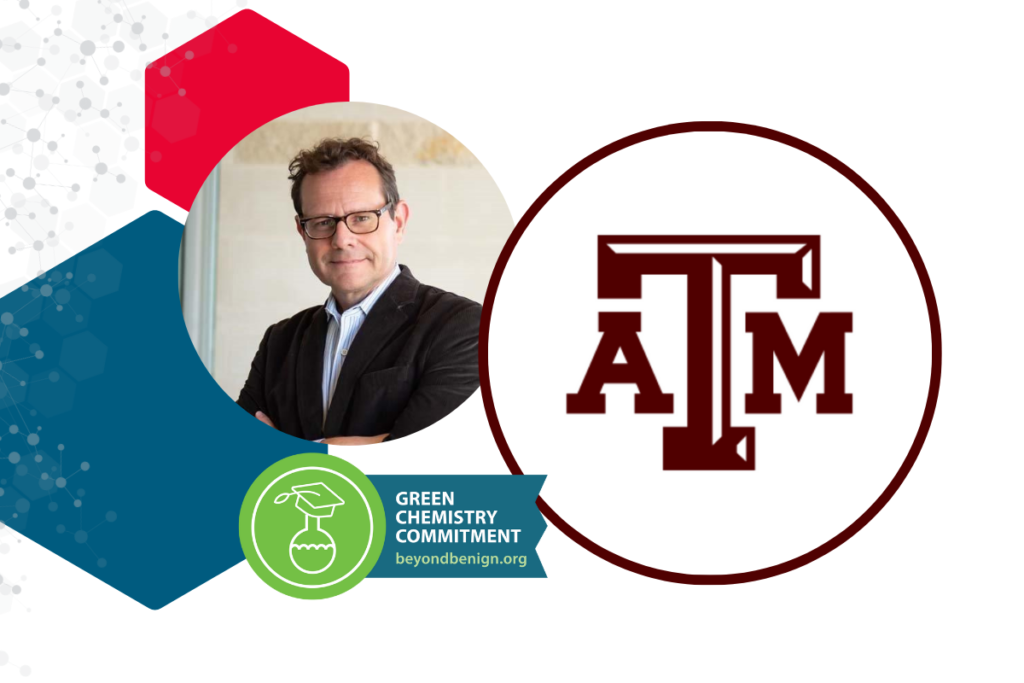
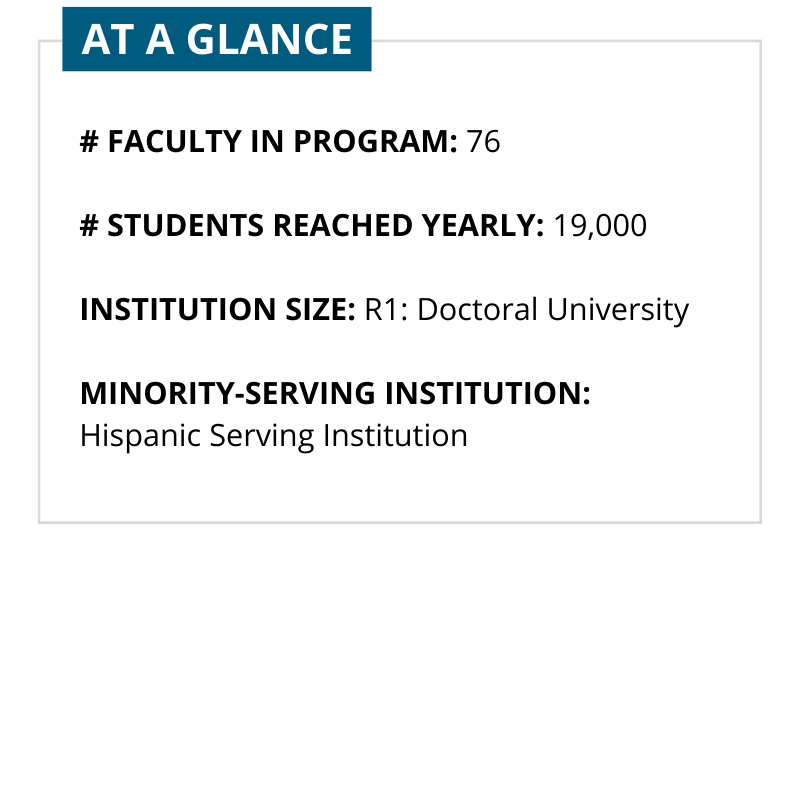
In 2013, Beyond Benign created the Green Chemistry Commitment (GCC) program with guidance from higher education institutions as a framework to unite the global green chemistry community. The GCC goal is to infuse green chemistry into Higher Education and give scientists the required skills to design processes and products less hazardous to human health and the environment.
Beyond Benign has partnered with companies including Dow, MilliporeSigma, and Biogen to further its mission to empower educators to transform chemistry education for a sustainable future. Support from these partners has allowed Beyond Benign to create resources, foster relationships, and provide essential funding to educators, all in an effort to grow and strengthen the green chemistry education community.
Texas A&M is a Dow academic partner and GCC signer. Discover the university’s story in our interview with D. Wayne Goodman Professor in Chemistry James Batteas.
How has being part of the GCC impacted your institution and you as a faculty member?
Since becoming a GCC signer in April of 2021, TAMU Chemistry has continued to build up its curriculum and research opportunities that expose our students, and the broader Bryan/College Station community, to the benefits of green, sustainable chemistry. While we already had a course specifically in green chemistry (since 2011), we are expanding our portfolio of educational programs to include activities such as our Youth Adventure Camp (YAP) in Mechanochemistry, first offered in the Summer of 2022. Students also garner direct research experiences in green chemistry via our current NSF REU program on Biological, Green, and Materials Chemistry, and through the NSF Center for the Mechanical Control of Chemistry (CMCC), for which TAMU is the lead institution. Students in our REU program participate in a weekly workshop on green chemistry, tour a DOW plant that focuses on sustainable packaging, and prepare general audience outreach (mostly videos) on green chemistry topics. The experience is aimed at increasing their awareness and understanding of green chemistry practices and principles. For me personally, as the Director of the CMCC, the partnership between TAMU, Dow Chemical, and Beyond Benign has helped me establish unique opportunities for our students, such as our YAP camp.
What student outcomes have you observed since instituting green chemistry practices and principles?
While we have yet to initiate a formal evaluation process, anecdotally, we have observed that a number of TAMU chemistry students choose green chemistry related topics for their senior seminar course projects and include discussions on green chemistry in their talks and papers, even when that’s not the primary focus. Additionally, our
Green Chemistry course continues to be a popular course for our students majoring and minoring in chemistry.
How do you envision the GCC community supporting the future green chemistry goals of your institution and training of your students?
It is our hope that the GCC community will serve as a resource for helping to build our green chemistry curriculum, and likewise, will help us disseminate the curricular and research activities and innovations that we have been developing at TAMU to other GCC partner institutions. We also hope that the GCC community will continue to foster a collaborative network between GCC institutions, to exchange ideas, and enable broader engagement across all stakeholders, academic, industrial, and governmental entities, to forward actions that enable the future of sustainable chemistry.
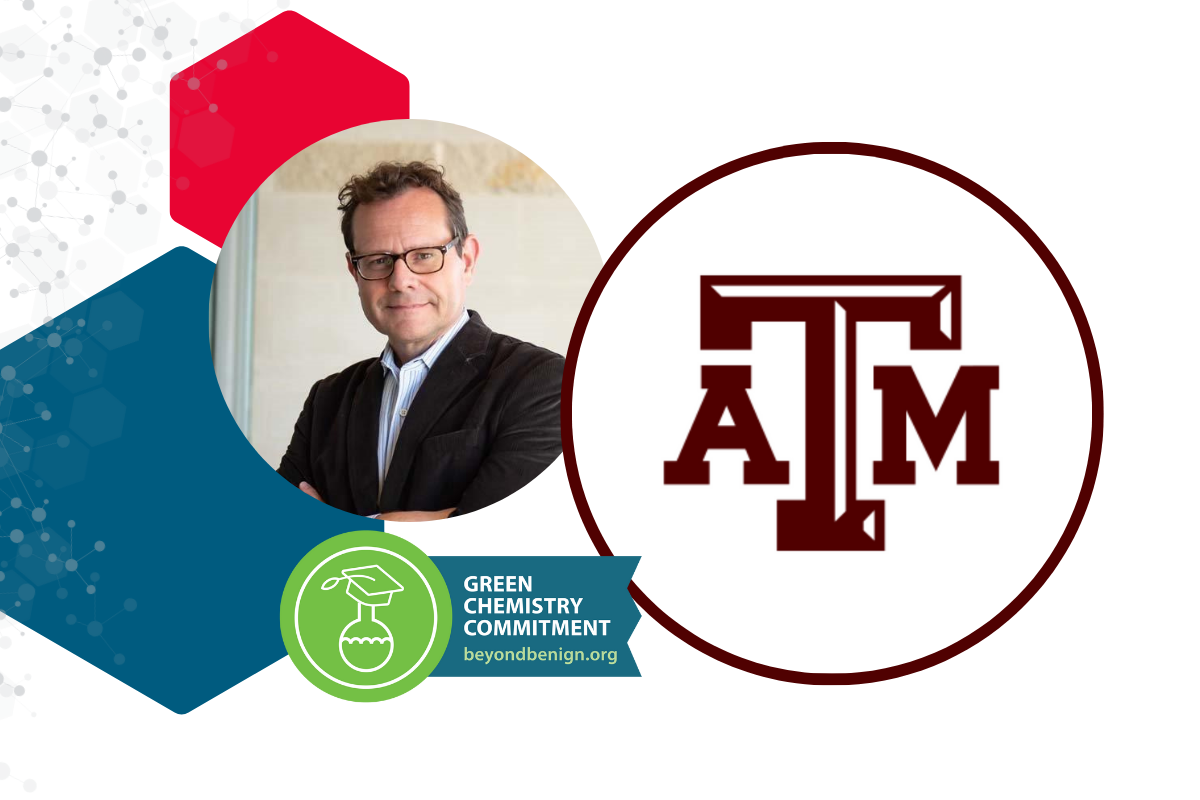
An Expanding Portfolio of Green Chemistry Programs at Texas A&M
October 15, 2023
An interview with James Batteas In 2013, Beyond Benign created the Green Chemistry Commitment (GCC) program with guidance from higher education institutions as a framework to unite the global […]
Categories: Green Chemistry Education, Higher-Ed
Incorporating Green Chemistry Principles into Chemistry Fundamentals Education at UC Santa Barbara
An interview with Morgan Gainer
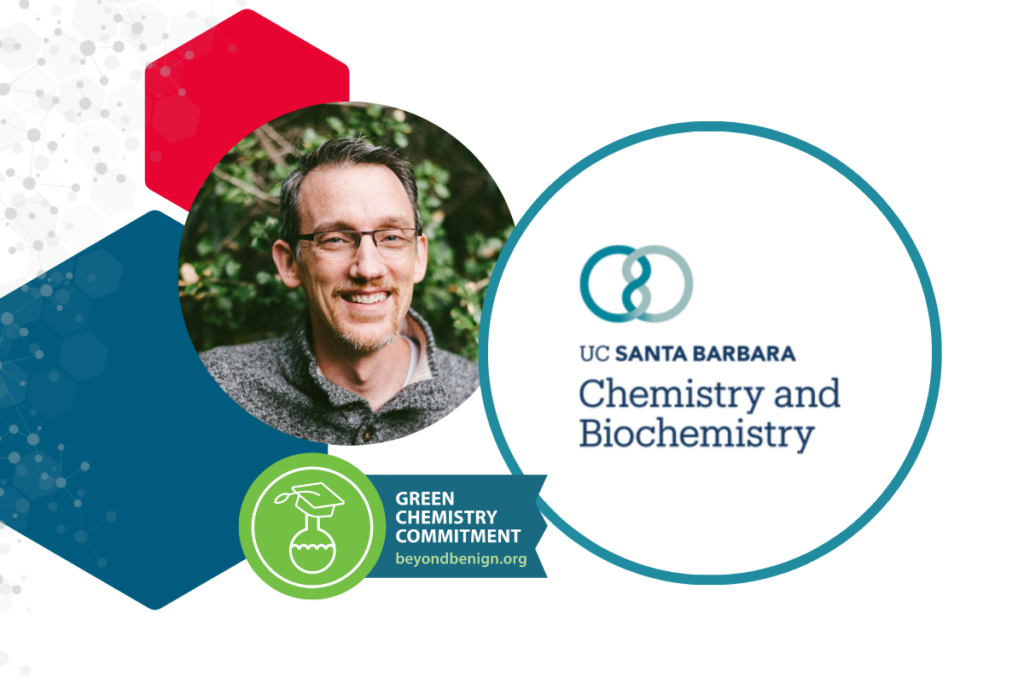
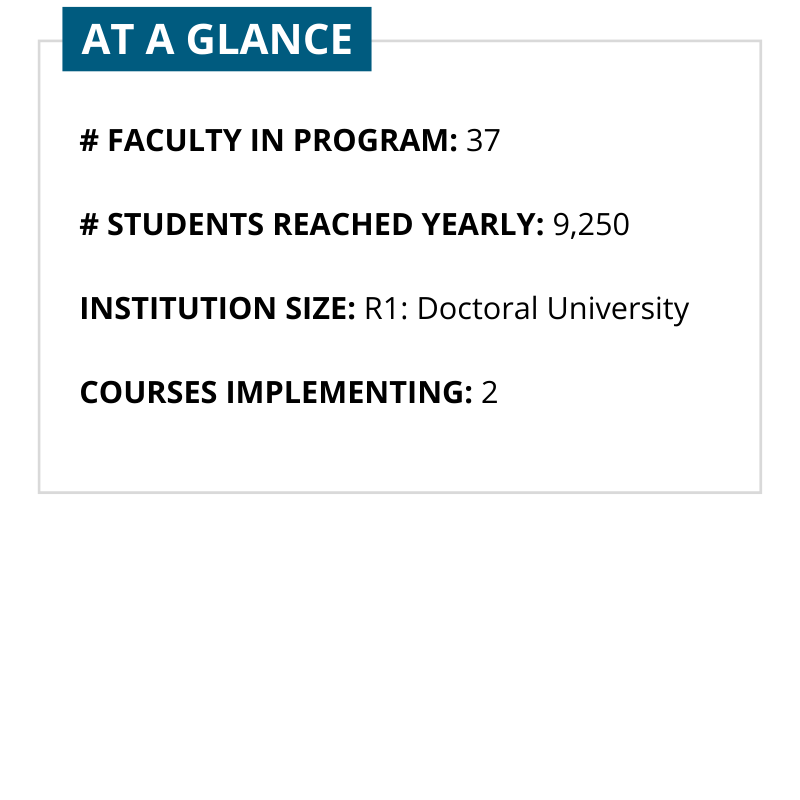
In 2013, Beyond Benign created the Green Chemistry Commitment (GCC) program with guidance from higher education
institutions as a framework to unite the global Green Chemistry community. The GCC goal is to infuse Green Chemistry into Higher Education and give scientists the required skills to design processes and products less hazardous to human health and the environment.
Beyond Benign has partnered with companies including Dow, MilliporeSigma, and Biogen to further its mission to empower educators to transform chemistry education for a sustainable future. Support from these partners has allowed Beyond Benign to create resources, foster relationships, and provide essential funding to educators, all in an effort to grow and strengthen the Green Chemistry education community.
UC Santa Barbara is a Dow academic partner and GCC signer. Discover the university’s story in our interview with Chemistry Lecturer Morgan Gainer.
How has being part of the GCC impacted your institution and you as a faculty member?
I am the director for the undergraduate organic chemistry laboratories at UCSB and have appreciated the many resources that the GCC has available to facilitate the implementation of green chemistry principles and practices. We have implemented green chemistry practices into many of our organic chemistry experiments, allowing us to highlight green chemistry at the same time that students are learning about fundamental organic chemistry reactions and techniques. This implementation has resulted in reduced waste generation, improved performances in the students’ experiments, and a greater understanding for our students of the importance of green chemistry.
What student outcomes have you observed since instituting green chemistry practices and principles?
We have observed that students are gaining a great appreciation for, and understanding of, green chemistry principles. We have been able to incorporate many green principles into our educational labs. As part of this incorporation, we have them evaluate an experiment to determine in what ways the experiment does or does not meet the principles of green chemistry. The students have responded positively to this experience, and it is clear that they understand the value of green chemistry, both for themselves personally and for society as a whole.
How do you envision the GCC community supporting the future green chemistry goals of your institution and training of your students?
We will continue to design and implement educational experiences for our students that incorporate green chemistry principles. I believe the GCC community overall has a passion for both green chemistry and education, and that the GCC can play an important role as educators support one another in their efforts to train up the next generation of chemists and scientists.
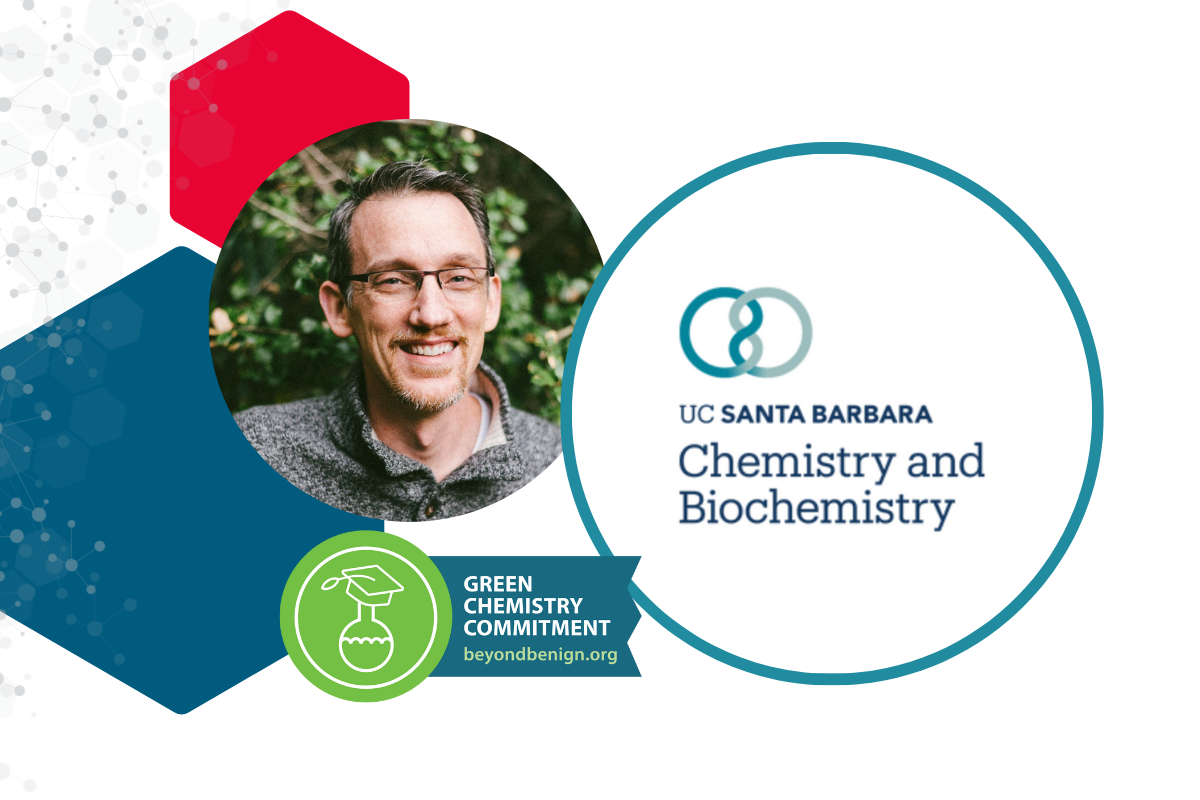
Incorporating Green Chemistry Principles into Chemistry Fundamentals Education at UC Santa Barbara
October 15, 2023
An interview with Morgan Gainer In 2013, Beyond Benign created the Green Chemistry Commitment (GCC) program with guidance from higher education institutions as a framework to unite the global Green […]
Categories: Green Chemistry Education, Higher-Ed
A Growing Community of Green Chemists at Southern University
An interview with Conrad Jones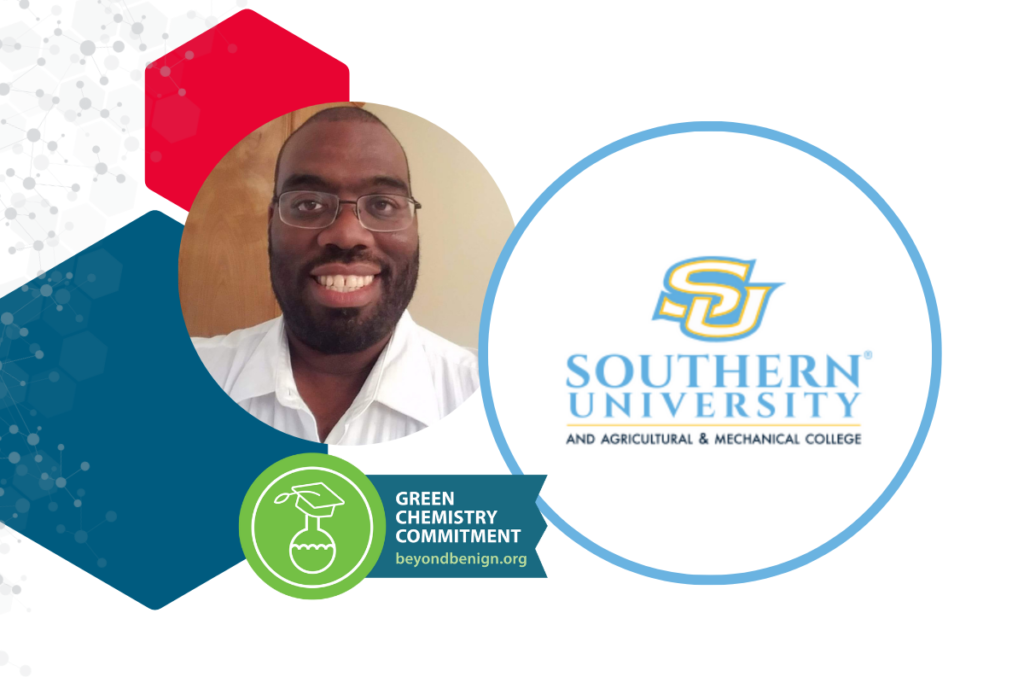
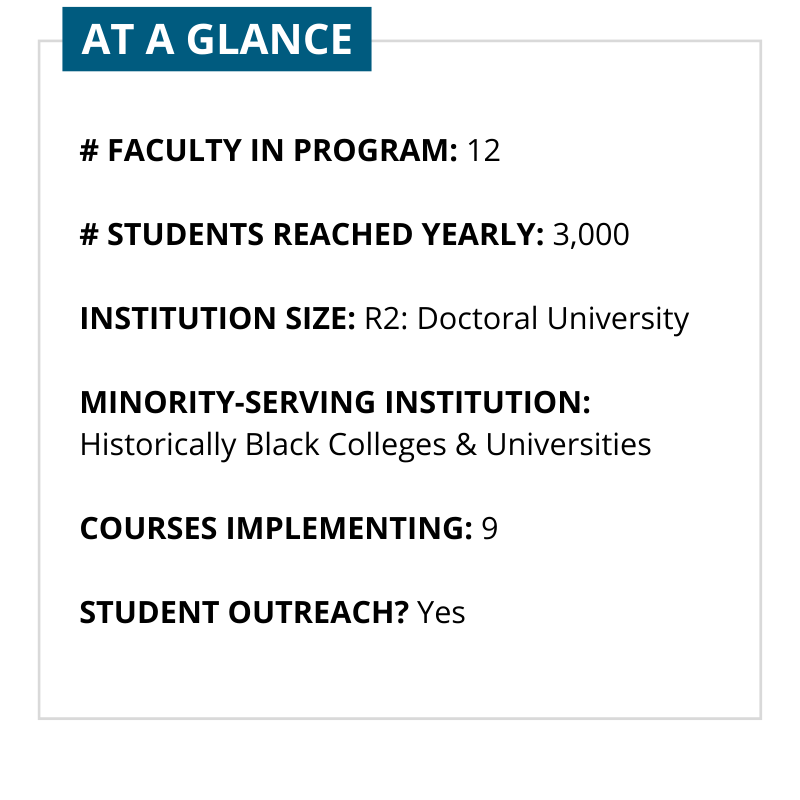
In 2013, Beyond Benign created the Green Chemistry Commitment (GCC) program with guidance from higher education institutions as a framework to unite the global green chemistry community. The GCC goal is to infuse green chemistry into Higher Education and give scientists the required skills to design processes and products less hazardous to human health and the environment.
Beyond Benign has partnered with companies including Dow, MilliporeSigma, and Biogen to further its mission to empower educators to transform chemistry education for a sustainable future. Support from these partners has allowed Beyond Benign to create resources, foster relationships, and provide essential funding to educators, all in an effort to grow and strengthen the green chemistry education community.
Southern University is a Dow grant winner and GCC signer. Discover the university’s story in our interview with Assistant Professor of Chemistry Conrad Jones.
How has being part of the GCC impacted your institution and you as a faculty member?
The impact that GCC has on our chemistry department at Southern University has been tremendous. STEM students enrolled in our General Chemistry courses are introduced to green chemistry concepts in both lecture and lab courses. During this 2022-2023 academic year, green chemistry concepts have been incorporated in General Chemistry, Analytical Chemistry, and Organic Chemistry courses.
As a faculty member, I am very thrilled and appreciative of being part of the GCC in helping students and faculty in the chemistry department as well as other departments at Southern University. In addition, it has given me the opportunity to provide students with the knowledge and skills to learn and apply green chemistry concepts to chemistry to prepare them for the workforce in the area of green chemistry.
What student outcomes have you observed since instituting green chemistry practices and principles?
Since the start of implementing green chemistry concepts and practices into the chemistry curriculum at Southern University, we have noticed that many students have developed a strong interest in knowing more about green chemistry and inquire about being involved in green chemistry projects in the chemistry department at Southern University. Each semester since being awarded the grant, a faculty member in our department has given a Zoom presentation about green chemistry and its applications in a given area of chemistry. During these presentations, we present students with questions before, during, and after the presentations in regard to their knowledge of green chemistry. Even though many students had heard about green chemistry before the talk, few students had a real sense of what green chemistry is and its role in our society. However, during and after the presentations, many of those students were able to define and know what green chemistry is and its significance to society and the environment.
How do you envision the GCC community supporting the future green chemistry goals of your institution and training of your students?
I envision that the GCC community will continue to greatly support our green chemistry goals and training of our students at Southern University. However, I also want our chemistry department and our university to aid the GCC community’s mission and objective to talk about green chemistry and be very active with GCC and the community. With GCC’s continuing support of Southern University and its students, our students can become effective contributors in showing others how to use green chemistry to enhance the quality of life and the environment. I am very appreciative and thankful for the opportunity that Beyond Benign and Dow Chemical has given to my fellow co-PIs on this grant (Dr. Wendy Wang and Dr. Maryam Jahan), the Southern University Chemistry Department, and Southern University for being part of the GCC community.
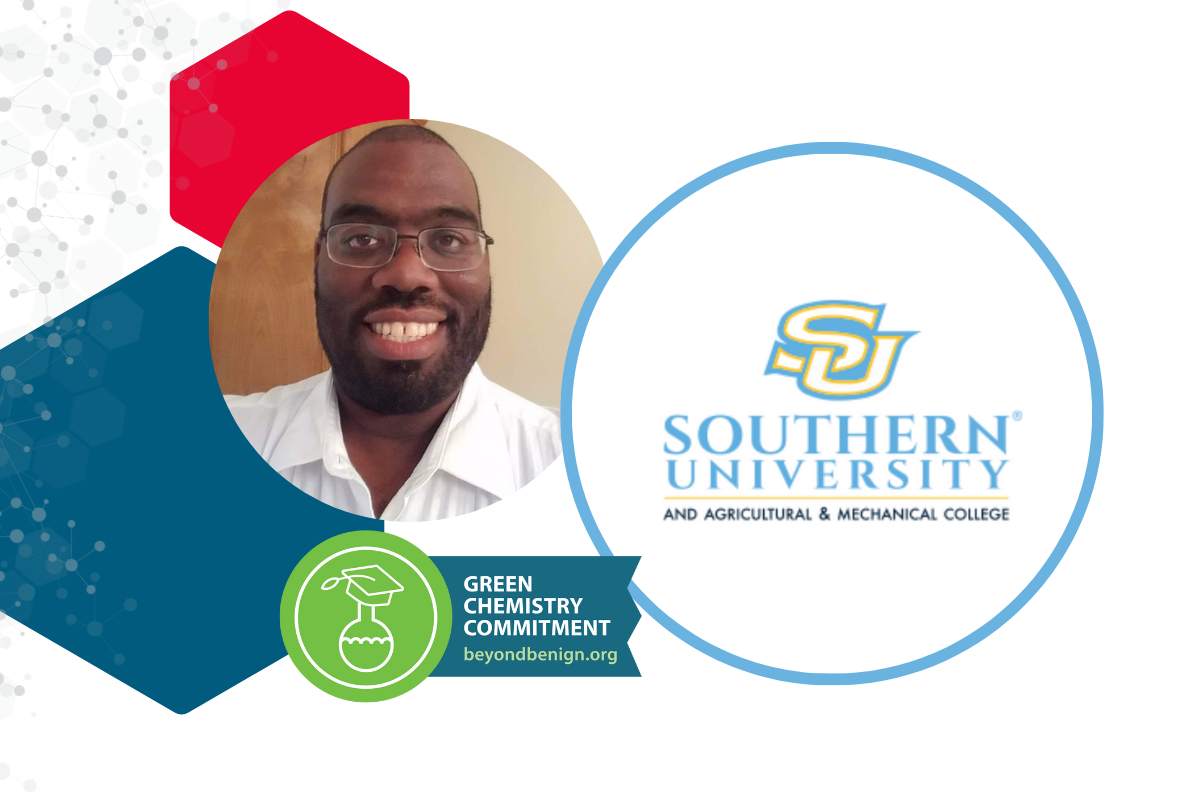
A Growing Community of Green Chemists at Southern University
October 15, 2023
An interview with Conrad Jones In 2013, Beyond Benign created the Green Chemistry Commitment (GCC) program with guidance from higher education institutions as a framework to unite the global green chemistry […]
Categories: Green Chemistry Education, Higher-Ed
‘Go Green!’: Green Chemistry Flourishes at Michigan State University
An interview with Rob Maleczka and James E. “Ned” Jackson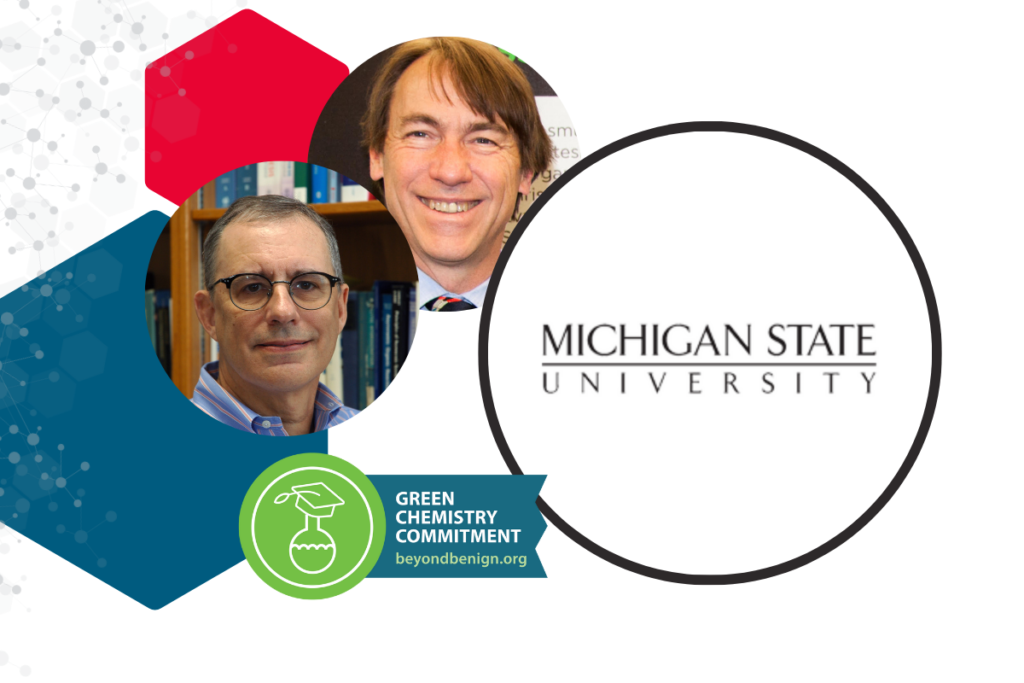
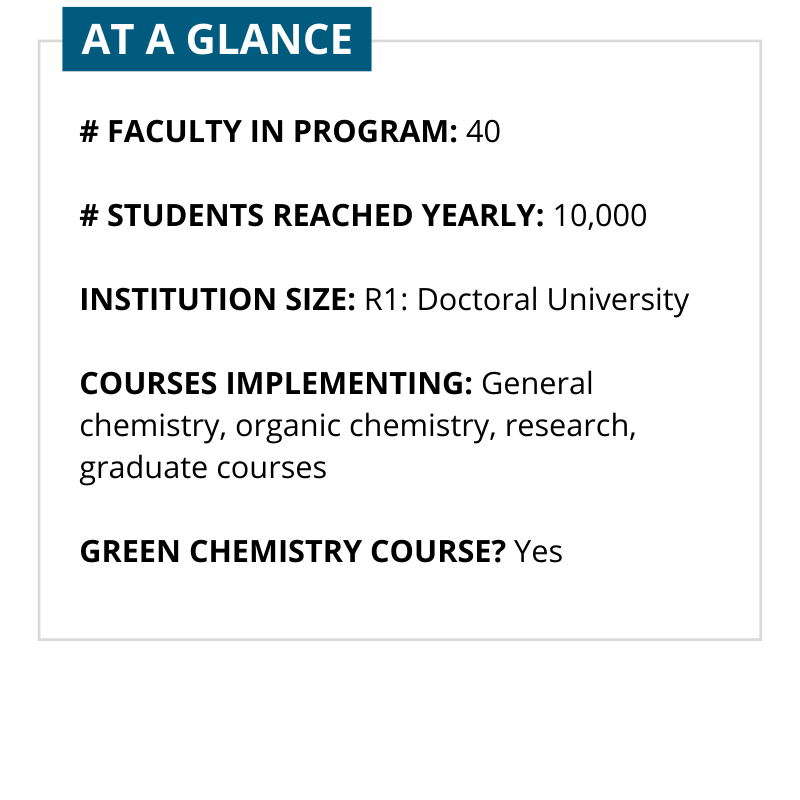
In 2013, Beyond Benign created the Green Chemistry Commitment (GCC) program with guidance from higher educatio
ninstitutions as a framework to unite the global green chemistry community. The GCC goal is to infuse green chemistry into Higher Education and give scientists the required skills to design processes and products less hazardous to human health and the environment.
Beyond Benign has partnered with companies including Dow, MilliporeSigma, and Biogen to further its mission to empower educators to transform chemistry education for a sustainable future. Support from these partners has allowed Beyond Benign to create resources, foster relationships, and provide essential funding to educators, all in an effort to grow and strengthen the Green Chemistry education community.
Michigan State University (MSU) is a Dow grant winner and GCC signer. Discover the university’s story in our interview with Professor Rob Maleczka and Professor James E. “Ned” Jackson.
How has being part of the GCC impacted your institution and you as a faculty member?
Rob: At Michigan State, green chemistry has long been part of the conversation. (After all, “Go Green” is part of the MSU lexicon!) For example, minimizing waste was among the drivers that led us to move to microscale labs decades ago. But making the Green Chemistry Commitment brought a sharper focus to those conversations, and teaching green chemistry became a more concrete goal. This is perhaps best illustrated by changes in our large enrollment organic sequence to labs that are not only inquiry-based but also built around Principles of Green Chemistry. We also now include a module on green chemistry in our course on chemical safety. And I think signing the GCC has provided added value to Professor Ned Jackson’s long running freshman seminar course on Green Chemistry. For me personally, being part of the GCC has motivated me not so much to change the specific body of chemistry that I’m teaching, but to change aspects of how I present that same chemistry.
Ned: Most of my own Green Chemistry activities are local. For instance, in my majors’ organic lectures, I describe and broadly illustrate the 12 Principles of Green Chemistry, including a special session on GC research at MSU. In my freshmen Green Chemistry seminar, besides the 12 Principles, we draw on environmental and historical stories of chemical syntheses (Hock cumene-phenol process), disasters (tetraethyllead in gasoline; global warming), triumphs (freons for refrigeration…) and unintended consequences (…but then ozone layer problems), showing how deep chemical understanding is needed to address many of the worlds largest problems. My own lab’s research has long had a focus on development of paths to make organic products and fuels from non-fossil sources. It is useful to know that the GCC offers resources and insights that I can access to enrich the work, both teaching and research. As an institution, and in collaboration with our chemical education colleagues, MSU has fully redesigned and updated our large non-majors organic lab experiences to include experiments that illustrate GC principles and metrics.
What student outcomes have you observed since instituting green chemistry practices and principles?
Rob: Students who are interested in joining my lab as undergraduate researchers are most definitely motivated by the prospect of making chemistry greener and more environmentally friendly. Perhaps just as significantly, they often bring with them pertinent green chemistry knowledge (e.g. which solvents are green and which aren’t). With the transformation of our lab courses, we now see students drawing conclusions made through the lens of the 12 Principles of Green Chemistry. Of course, what I’d like to think is that we’ve built the principles into their broader views on the environment and sustainability, as well as society and the economy. To be honest, I don’t know if we have achieved these larger outcomes. But this question has got me thinking that we should try to find out!
Ned: Students show gains in awareness and desire to connect chemistry to broader interests in environmental science, sustainability, critical evaluation of news and advertising, etc. Overall, their appreciation of chemistry as much more than an academic subject is expanded. Also growing is student interest in participating in research projects aimed at “greening” the world’s major chemical processes—energy, plastics, pharmaceuticals, recycling, etc.
How do you envision the GCC community supporting the future green chemistry goals of your institution and training of your students?
Rob: Maybe the GCC community can help with the last part of my answer to question 2! I see the GCC community as a catalyst that leads us to further refresh and renew Chemistry’s curriculum. As we do so, Beyond Benign’s resource gathering and sharing is sure to be helpful. Ideally, I’d also like to envision the GCC community becoming even more integrated in graduate education and training. In this regard, bringing more industrial partners into the community to better chart the role green chemistry can play in the professional development of our students would be terrific. Lastly, it would be a violation of some sort of faculty code if I didn’t say: it would also be terrific if to help support green chemistry goals, the GCC community were to work together on finding new ways to shake loose the needed funding from our respective administrations!
Ned: Though there is much material we draw on even within the academic ecosystem of MSU, I think we need to more thoroughly survey the offerings and exploit the stories and expertise accessible via our connection to the GCC. It is inspiring to have a clearinghouse for the creativity others have brought to both teaching and research efforts, illustrating both the significant needs, and the dynamism and versatility of tools, ideas, and new options that chemistry still offers.
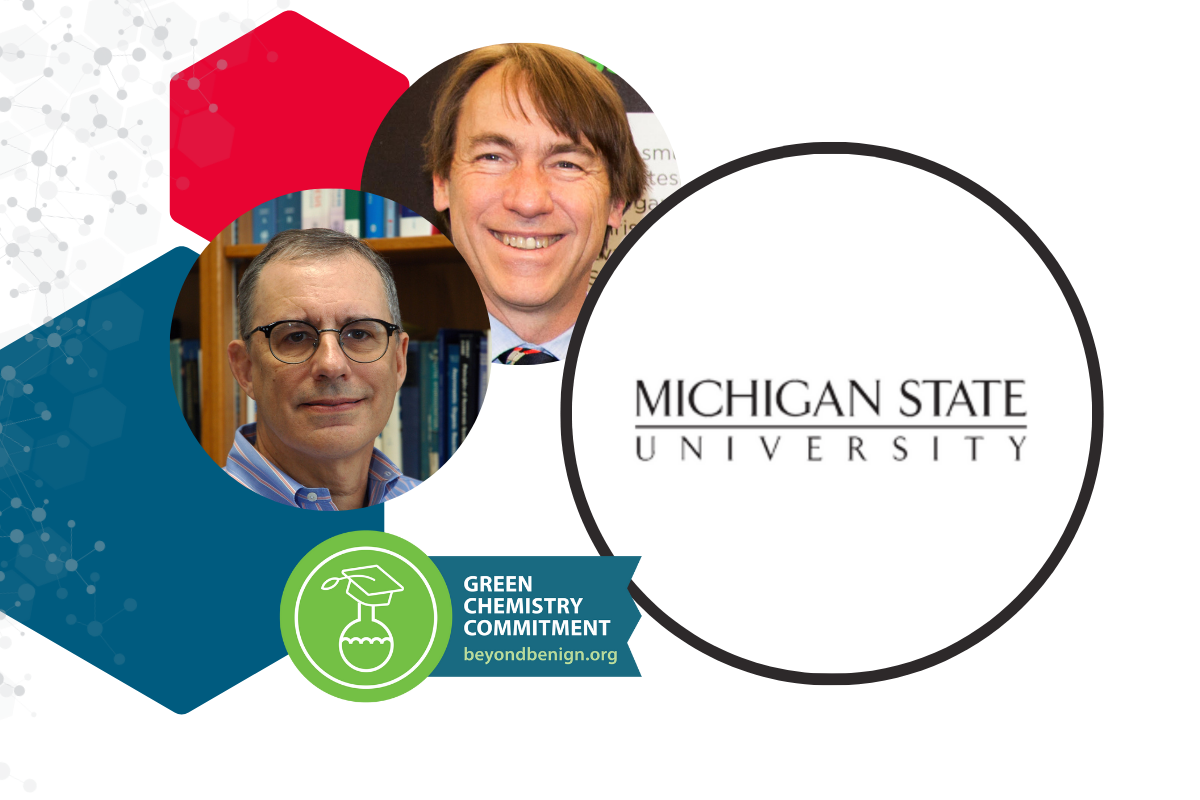
‘Go Green!’: Green Chemistry Flourishes at Michigan State University
October 15, 2023
An interview with Rob Maleczka and James E. “Ned” Jackson In 2013, Beyond Benign created the Green Chemistry Commitment (GCC) program with guidance from higher educatio ninstitutions as a framework […]
Categories: Green Chemistry Education, Higher-Ed
Growing Community, Connections and Inspiration at Prairie View A&M University
An interview with Andrea Oseolorun
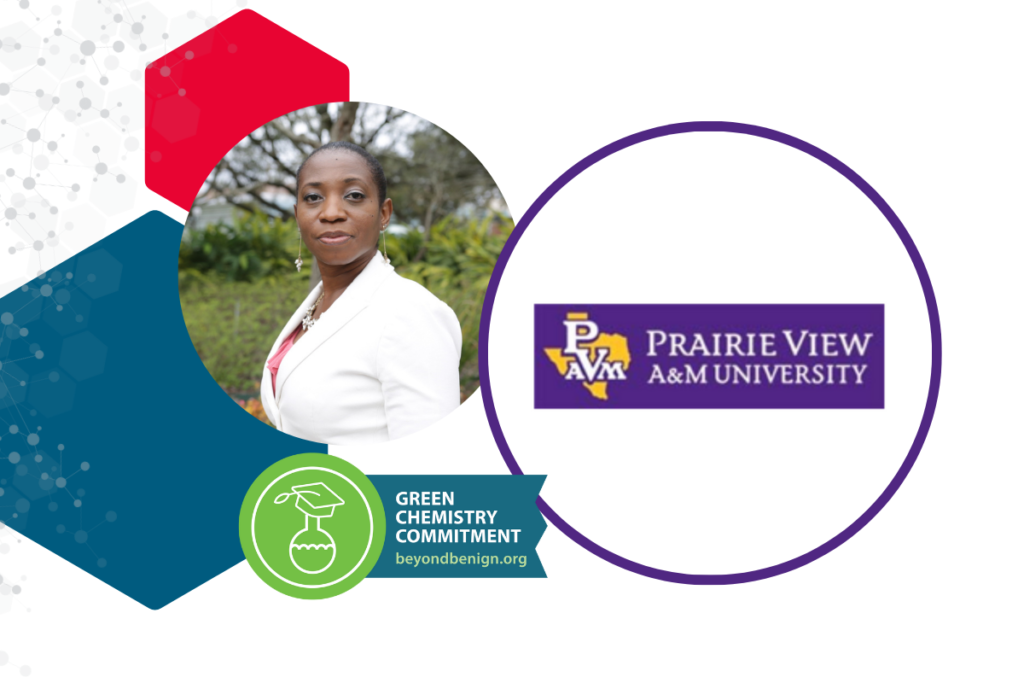
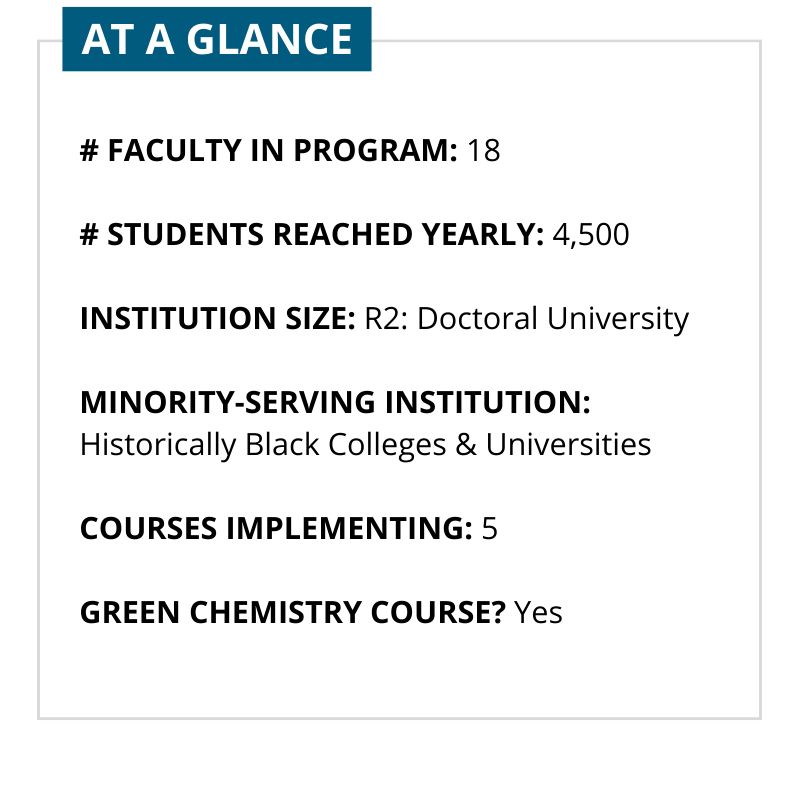
In 2013, Beyond Benign created the Green Chemistry Commitment (GCC) program with guidance from higher education institutions as a framework to unite the global Green Chemistry community. The GCC goal is to infuse Green Chemistry into Higher Education and give scientists the required skills to design processes and products less hazardous to human health and the environment.
Beyond Benign has partnered with companies including Dow, MilliporeSigma, and Biogen to further its mission to empower educators to transform chemistry education for a sustainable future. Support from these partners has allowed Beyond Benign to create resources, foster relationships, and provide essential funding to educators, all in an effort to grow and strengthen the Green Chemistry education community.
Prairie View A&M University is a Dow academic partner and GCC signer. Discover the university’s story in our interview with Dr. Andrea Oseolorun.
How has being part of the GCC impacted your institution and you as a faculty member?
Signing on to the GCC has opened so many doors for our department, including new collaborations, new research directions, increased interest in more green and sustainable chemistry projects and proposals, more publications targeting green chemistry journals, and a new green chemistry course based on resources provided by Beyond Benign and other partners.
As a scientist from an interdisciplinary background in a department filled with Ph.D. chemists, [the GCC] has given me a voice and a way to show what I can offer to the academy. It has also allowed me to introduce my students to a subject that is of particular interest to me coming from an environmental science background.
What student outcomes have you observed since instituting Green Chemistry practices and principles?
I’ve always envisioned creating an environmental chemistry course in my department, and the encouragement I’ve received from the GCC community has built my confidence to move forward with the project. I have found my feet and my voice, literally, and I am looking forward to bigger things because of the assistance from my colleagues in the GCC. I have experienced a genuine sense of belonging as a scientist that was not there before.
It’s also helped me connect with new colleagues and students across the globe. I’ve met students in Berlin who are doing great work to advance green chemistry in the University. I have talked with colleagues in Canada and multiple states across the U.S., and I hope to work on research projects in the future.
How do you envision the GCC community supporting the future green chemistry goals of your institution and training of your students?
We hope to always have a forum to share our ideas and also learn from the community. We would like to see more outreach to support our efforts to increase awareness of the benefits of this new, more sustainable enterprise and how vital green chemistry education is to student success.
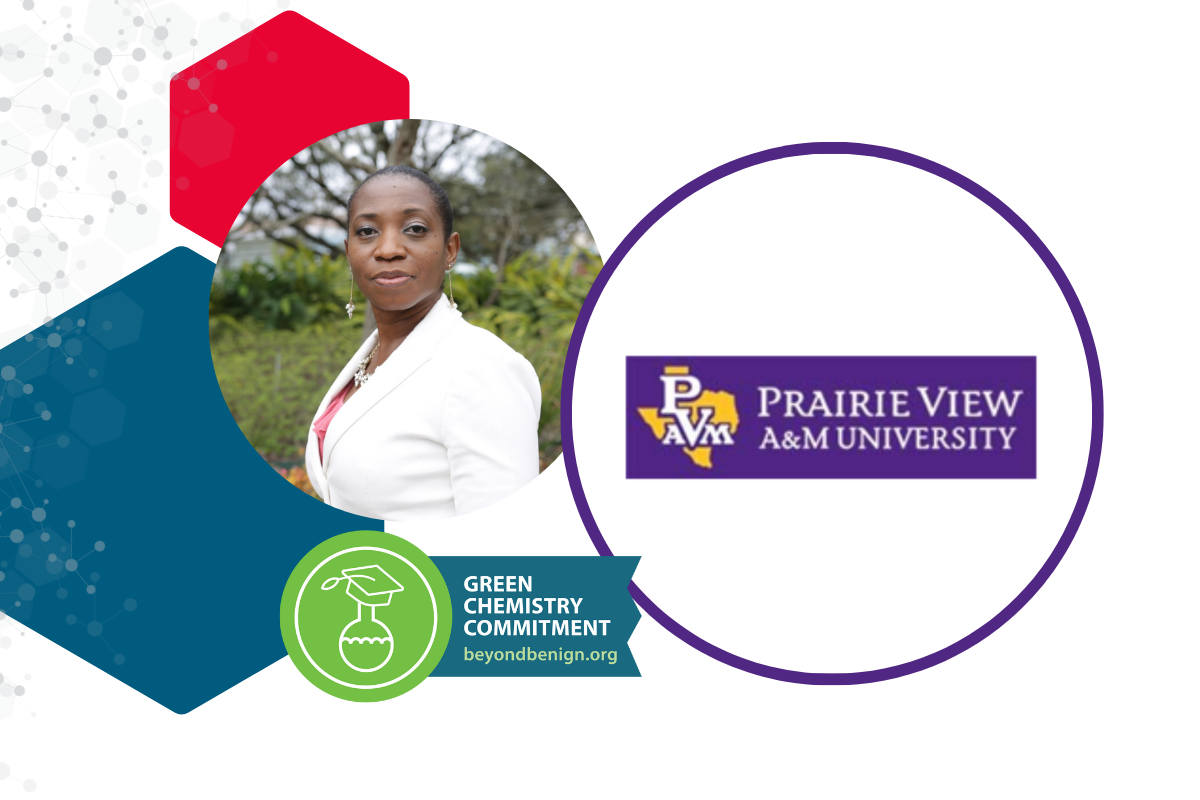
Growing Community, Connections and Inspiration at Prairie View A&M University
October 15, 2023
An interview with Andrea Oseolorun In 2013, Beyond Benign created the Green Chemistry Commitment (GCC) program with guidance from higher education institutions as a framework to unite the global Green […]
Categories: Green Chemistry Education, Higher-Ed
Green Chemistry Research Interest Grows at the University of Minnesota
An interview with Jane Wissinger
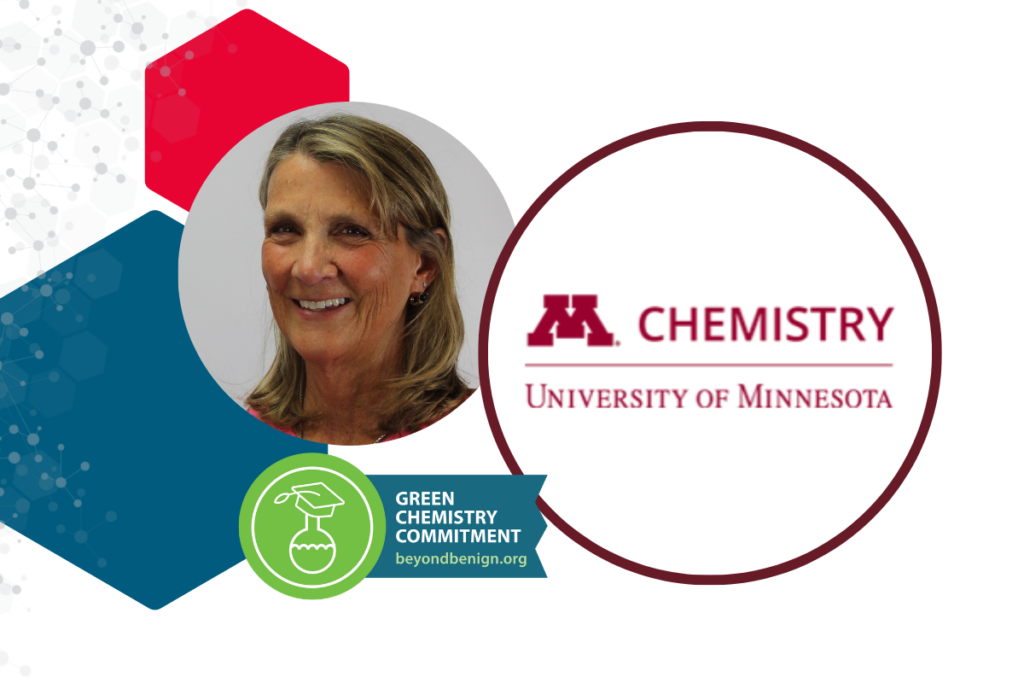
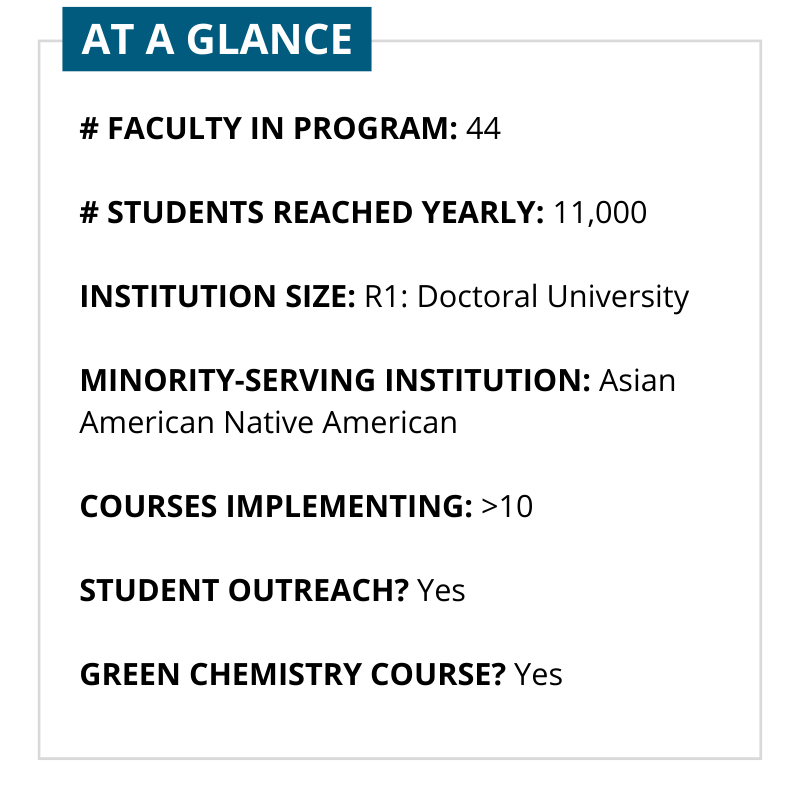 In 2013, Beyond Benign created the Green Chemistry Commitment (GCC) program with guidance from higher education institutions as a framework to unite the global Green Chemistry community. The GCC goal is to infuse Green Chemistry into Higher Education and give scientists the required skills to design processes and products less hazardous to human health and the environment.
In 2013, Beyond Benign created the Green Chemistry Commitment (GCC) program with guidance from higher education institutions as a framework to unite the global Green Chemistry community. The GCC goal is to infuse Green Chemistry into Higher Education and give scientists the required skills to design processes and products less hazardous to human health and the environment.
Beyond Benign has partnered with companies including Dow, MilliporeSigma, and Biogen to further its mission to empower educators to transform chemistry education for a sustainable future. Support from these partners has allowed Beyond Benign to create resources, foster relationships, and provide essential funding to educators, all in an effort to grow and strengthen the Green Chemistry education community.
The University of Minnesota (UMN) is a Dow academic partner and founding GCC signer. Discover the university’s story in our interview with Morse-Alumni Distinguished Teaching Professor, Jane Wissinger.
How has being part of the GCC impacted your institution and you as a faculty member?
Since signing the GCC in 2013, many new and diverse initiatives evolved through the support and resources provided through this program. Green chemistry was already incorporated in the organic laboratory course, but the GCC sparked interest in developing a dedicated green chemistry upper-division lecture course. This course has been taught by five different faculty instructors, each with their own influences and research connections, expanding the breadth and diversity in green chemistry and engineering concepts for our students.
Being part of the GCC encouraged the addition of toxicology into the course and fostered collaborations with departments such as the MN School of Public Health as well as state agencies such as the Minnesota Pollution Control Agency. Personally, these interactions opened opportunities of learning and examples of new curriculum content to continue improving upon my own courses as well as disseminating ideas to other instructors for their courses.
What student outcomes have you observed since instituting Green Chemistry practices and principles?
Student outcomes are evident at both the undergraduate and graduate student levels. At the undergraduate level, students who were introduced to green chemistry were increasingly interested in research opportunities where they could apply the principles. In the last three years, the ACS MN student chapter made a concerted effort to increase green chemistry programming and won a Green Chemistry Chapter award in 2022.
At the graduate student level, two major efforts have emerged. One involves our department’s Joint Safety Team (JST) that promotes reducing risk through substitution or elimination of the hazards when possible and provides resources through their website. Second, is a new committee called the Sustainable and Green Chemistry committee that is comprised of graduate students, staff, postdocs, undergraduates, and faculty all working together to build a culture of sustainability and green chemistry in the department. The graduate students, in particular, are working to improve sustainability practices in the research laboratories.
How do you envision the GCC community supporting the future green chemistry goals of your institution and training of your students?
I believe it is important that students at all levels see evidence that their academic training will be relevant to their future careers, and that their careers will have an impact on society. This applies to both academic and industrial positions. The fact that companies such as DOW are backing this initiative is of HUGE consequence and illustrative of the fact that green and sustainable chemistry is increasingly valued by the entire chemical enterprise; not just educators.
I envision the GCC continuing to provide a strong community of educators with resources and opportunities to build bridges between student training and industrial partners. This will enable chemistry students to see themselves in a career that can have a profound impact for the future.
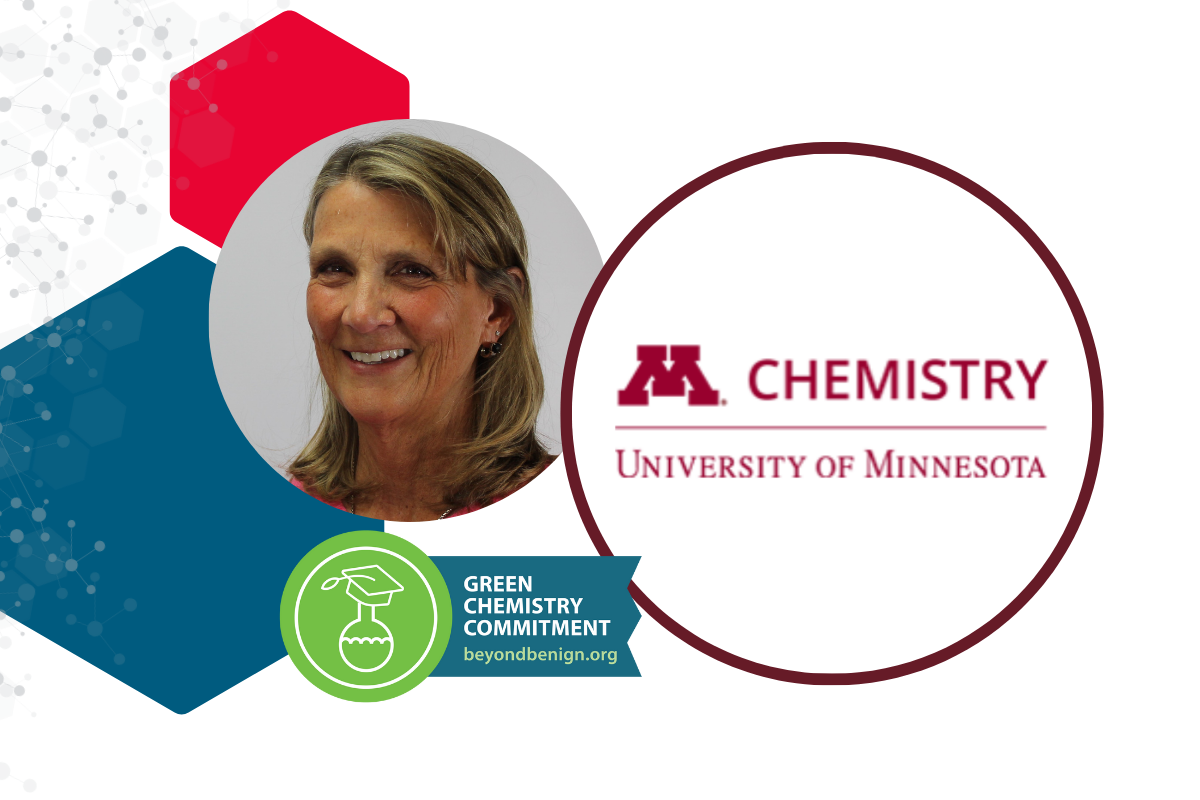
Green Chemistry Research Interest Grows at the University of Minnesota
October 15, 2023
An interview with Jane Wissinger In 2013, Beyond Benign created the Green Chemistry Commitment (GCC) program with guidance from higher education institutions as a framework to unite the global Green […]
Categories: Green Chemistry Education, Higher-Ed
- « Previous Page
- 1
- 2
- 3
- 4
- 5
- …
- 15
- Next Page »
